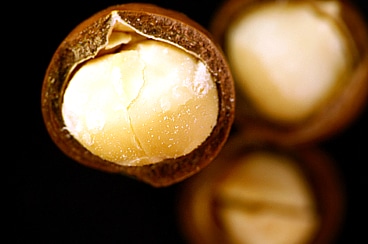Hawaiian Macadamia Nuts
A visit to the Hamakua Macadamia Nut Company's factory
ISLANDS Audio Series: Hear author Matthew Miller's audio account of cracking macadamia nuts on the Big Island.
"The secret? Getting your nuts as dry as possible," Richard Schnitzler, President of Hamakua Macadamia Nut Company tells me. We're standing amid a scattering of nutshells next to a row of fire-heated nut-drying silos on the the Big Island of Hawaii. A warm breeze drifts up from the Pacific Ocean along the lava- riddled north Kohala coast. On the way here I passed the imposing ceremonial site built by Kamehameha the Great as he unified the islands. The scenery looks distinctly Hawaiian, but the vapor from the drying Hawaiian macadamia nuts brings it home.
That scent always evokes Hawaii for me, ironic given that macadamia trees were introduced from Australia. Since 1881, however, the nut has established its credentials as a key flavor of aloha. Hawaii grows only about a quarter of the world's macadamia nuts, Richard tells me, but it processes many of the nuts produced elsewhere, and most macadamia-tree cultivars planted worldwide come from the state. I nod impatiently as he presents these facts. I haven't gotten to eat any Hawaiian macadamia nuts yet.
I have always loved macadamias, but at home the Mauna Loa company's signature pale-blue label always seems to adorn empty cans. Some greedy housemate has always already eaten the entire contents. So I have come to the source. Hamakua claims to be the world's largest producer of high-grade Hawaiian-grown macs. I'm about to learn that the crucial thing is not their history nor the reason they're so delicious (high percentages of healthful polyunsaturated and monounsatura- ted fat by volume). It's how many Hawaiian macadamia nuts you can stuff in your mouth and cram in your pockets for later.
But first Richard shows me the mound of unshelled nuts filtering down to the industrial-strength nutcracker. It's like he's toying with me. From the outside, the operation looks just like any old factory. "My consultants tell me I'm not selling enough water," he says, meaning nuts with higher water content, "but I'd rather sell more delicious nuts." Water content below 1 percent, he says, gives you much better-tasting nuts. Macs absorb atmospheric moisture, so there's a drying limit. Even Chile's Atacama Desert, one of the driest regions on earth, has relative humidity above 2%, and the Big Island is a lot wetter than Atacama. When the weather gets humid, the nuts get humid. And humid nuts don't taste as good. They're not as crisp. The oil and water don't mix well.
"You can taste the difference between 1.5 and 1 percent water content?" I ask. I find that hard to believe, but I'm willing to do a blind test as long as it involves eating a lot of Hawaiian macadamia nuts. "That's a big difference," he says, directing me into the factory lobby. "Can you get water content to zero?" I ask, grasping for the nutty grail. He smiles at me. "That would be hard," he says. "We get pretty close." He leads me to a bin of dried nuts in the shell. I pick one up. "What's the water content in this one?" I say, holding it out as if he can measure water content through the shell with his eyeballs. "A little under 1 percent," he says.
My mouth waters. I drop it into the jaws of the American-made macadamia cracker capable of generating the 300 pounds of pressure necessary to crack one of the world's toughest nuts. The shell cracks cleanly to reveal the whole dun-colored meat. Though dried, this nut is raw. The company sells flavored nuts (honey-roasted, wasabi, jalapeño), but this one isn't even salted. And it's the best macadamia, maybe the best nut of any kind, I've ever had, light but ample oils suspended in ethereal nutty flavor, not sugary but sweet like grain, a hint of fresh-baked bread.
I drop another nut into the jaws and lever down on it as I say, "Do you mind if I crack another one?" He smiles again, a wee bit indulgently I think, as I eat the nut. He should be in coat-tails and a top hat. I'd be content to stay here awhile longer, but Richard Schnitzler isn't done with me yet.
In the factory's roasting room, the fluorescent inner sanctum, he leads me up a ship ladder to a catwalk next to a conveyor that emerges from the grand automated roasting contraption. Here, the largest macadamia nuts I've ever seen, whole and spheroid and the color of white gold, come bounding out of the roaster onto the belt, bouncing and tumbling like happy children leaving school. I want to eat them.
"Try one," Richard says. He is Willy Wonka; I am Charlie Bucket. "Really?" I'm reluctant to put my grubby fingers into the pool of nuts. Down the chute, ladies in lab coats, gloves and hairnets cull nuts with imperfections from the race of flawlessly dry, unblemished macadamias. "Try one." I pick up two Hawaiian macadamia nuts, eat them both and burst out laughing. Warm, crisp, the subtle sugars redeemed by so much oil.
"These nuts are so dry!" I declare, picking up a couple more without asking, eating them. "Look, it's Elvis!" I point the other way and take a few more. I want to fill my pockets, but every macadamia nut I pick up I put in my mouth and eat. I can't help it. Richard smiles at me. I'm not sure he doesn't give me a wink. He knows. This is deliciousness.
